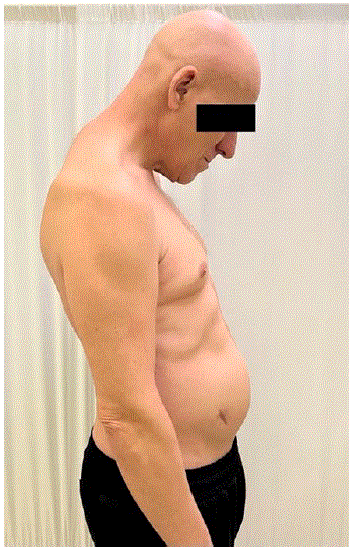ECE2023 Eposter Presentations Adrenal and Cardiovascular Endocrinology (124 abstracts)
A rare case of slowly progressing myopathy of unknown origin in a patient with Autoimmune polyglandular syndrome type 1 (APS-1)
Axenia Bondarenko 1 , Zhanna Belaya 1 , Liudmila Rozhinskaya 1 & Valentin Fadeyev 2
1Endocrinology Research Centre, Moscow, Russia; 2I.M. Sechenov First Moscow State Medical University (Sechenov University), Moscow, Russia
We report a 53-year-old man. At age 3, the patient was diagnosed with chronic mucocutaneous candidiasis. At age 41 the patient started losing all hair on the body with total boldness. At age 43, he first complained of muscle weakness resulting in difficulty walking, back pain and difficulties holding his head in an upright position. At age 49, he was diagnosed with chronic primary adrenal insufficiency and hypoparathyroidism. Genetic analysis confirmed APS-1 (c.769C>T p.R257X mutation in the AIRE gene). The patient received therapy with hydrocortisone 35 mg/day, fludrocortisone 0.5 mg/day, alfacalcidol 0.75-1 mg/day, colecalciferol 15,000 IU/week. On this treatment he had calcium levels within the reference range and no clinical signs of either hyper- or hypocortisolism. However, his muscle weakness gradually, although painlessly, progressed. At age 49 electroneuromyography showed signs of primary muscle damage: high-amplitude motor unit potentials and the absence of spontaneous muscle fiber activity were recorded. According to the results of a PET, specific metabolically active tissue was not identified, but there were described signs of atrophy of the paravertebral muscles, the left lumbar major muscle, and the gluteal muscles on both sides. There was a gradual progression in muscle weakness over time leading to serious difficulties in walking and the ability to maintain his head in the upright position (Fig1). The results of densitometry in the "Total Body" mode show signs of muscle atrophy: limb muscle mass–16793 g (normal range for men >19750 g), Baumgarten skeletal muscle index–6.24 kg/m2 (normal range for men >7.26). According to the most recent laboratory tests, an increase in the level of creatine phosphokinase to 411 U/l (normal range, 30-200 U/l), C-reactive protein to 9.8 mg/l (normal range, 0.1-5 mg/l) were detected. Grip strength measurements showed normal performance. When hydrocortisone was replaced with prednisolone, the level of creatine phosphokinase decreased to 184 U/l, and C-reactive protein decreased to 2 mg/l. No current evidence was found in favor of autoimmune damage to muscle tissue and no other muscle disease was detected.
Conclusion: The clinical case outlines a rare combination of APS-1 and central muscle atrophy of unknown origin, but probably related to mutation in the AIRE gene.

Figure 1. Involuntary position of the patient associated with atrophy of the vertebral muscles
 }
}



